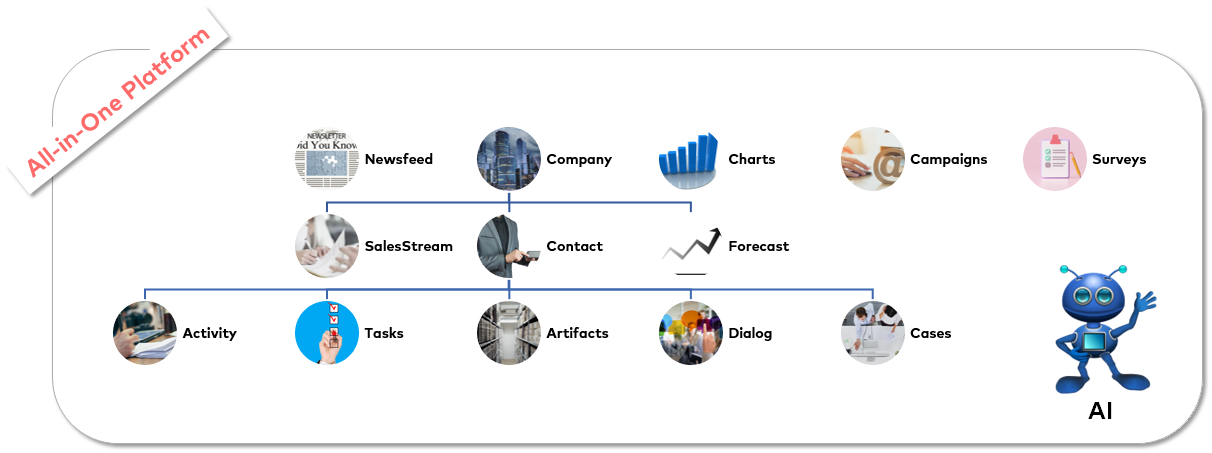Unified vs Niche
Two Approaches to Achieve the same Goal
In a dynamic city, there existed a vast maze where businesses of all kinds were in search of success, represented by "cheese" scattered throughout the labyrinth. This cheese symbolized growth, prosperity, and the pinnacle of industry innovation.
Evan and Ellie: Executives in a multi-million dollar fast-growing organization.
Mark and Maya: Two methodical business partners who preferred long-term strategic planning.
Evan and Ellie stumbled upon a substantial pile of cheese labeled "Product A." This product was revolutionary and promised significant improvements in efficiency and customer satisfaction. Wasting no time, Evan and Ellie bought Product A and integrated it into their operations. They saw immediate gains and were ecstatic.
Meanwhile, Mark and Maya also discovered Product A but approached it with caution. They meticulously analyzed the market, the potential impacts, and future trends. After a thorough review, they decided to invest in Product A, albeit after a considerable delay.
As weeks passed, Evan and Ellie noticed the effectiveness of Product A waning. Rather than panic, they scoured the maze for new opportunities, quickly discovering that enhancing Product A required additional tools: case management, productivity tools, customer surveys, analytics, and role-based newsfeeds. They invested in these supplementary products, maintaining their edge in the market through constant adaptation and swift action.
Mounting costs: To manage their budget, they had to limit subscriptions to each platform.
Creation of silos: Different teams only had partial access to customer data, which hindered their ability to scale and negatively impacted the customer experience.
Customer frustration: Customers had to repeatedly explain their situations to different team members, leading to dissatisfaction and a sense of disconnection.
Lack of a unified customer view: This required more personnel to support the growing customer base, further straining resources.
Learning multiple tools: Increased training time and costs.
Frequent context switching: Constant switching between tools reduced overall productivity, as employees struggled to remember which tool to use for each task, leading to mistakes and delays.
Mark and Maya took a different approach. As Product A's effectiveness diminished, they didn't rush to find a quick fix. Instead, they stepped back and developed a comprehensive long-term strategy. They envisioned a cohesive platform where their entire company could gain unified insights into customer behavior and needs. This platform would allow for rapid response to evolving customer demands, streamline operations, and foster greater efficiency.
They applied the Pareto Principle, focusing on the 20% of efforts that would yield 80% of the results. By concentrating on creating a unified platform, they aimed to address the most significant inefficiencies and enhance their customer experience profoundly.
Creating an integrated solution: A single platform that unified critical customer data into one seamless interface.
Saving on integration costs: Reducing the complexity of managing multiple subscriptions and lowering support expenses.
Enabling faster, higher-quality delivery of services: Providing deeper insights through advanced artificial intelligence.

They realized this approach would lead to:
Rapid response to evolving customer demands.
Streamlined operations.
Greater efficiency.
Mark and Maya's strategic approach to building a cohesive platform brought significant benefits, while Evan and Ellie's rapid adaptation with multiple tools created challenges. The following table outlines the key differences between their approaches:
| Aspect | Mark and Maya | Evan and Ellie |
|---|---|---|
| Platform Integration | Cohesive platform integrating case management, productivity tools, customer surveys, analytics, and role-based newsfeeds. | Multiple separate tools added as needed. |
| Operational Efficiency | Achieved higher efficiency, better customer responsiveness, and reduced operational costs. | Fragmented operations due to siloed information. |
| Customer Experience | Seamless and personalized customer experience, with all team members having complete understanding of each customer. | Fragmented customer experience, causing frustration and disconnection. |
| AI Insights | Generated more accurate AI insights using analytics, knowledge base articles, and activity notes summaries. | Limited AI insights due to fragmented data. |
| Knowledge Capture | System to capture and leverage expertise of top subject matter experts, accelerating team learning. | No unified system for knowledge capture, leading to slower adaptation. |
| Team Collaboration | Ensured cohesive operation through unified platform. | Frequent context switching, reducing productivity. |
| Personnel Requirements | Efficient resource use, no need for increased personnel. | Required more personnel due to inefficiencies. |
| Customer Loyalty | Fostered a sense of closeness and belonging, enhancing customer loyalty. | Decline in customer retention, tarnished reputation. |
Mark and Maya's cohesive platform enabled their entire team to work efficiently and provide a seamless, high-quality customer experience. This approach not only reduced operational costs but also enhanced customer loyalty and team collaboration through accurate AI insights and effective knowledge sharing.
In contrast, Evan and Ellie's reliance on multiple tools led to fragmented operations, frequent context switching, and increased personnel needs. Their inability to provide a unified customer experience resulted in customer frustration and a decline in loyalty. The scattered focus and divided attention within their teams further hindered their ability to scale effectively.
As the maze continued to evolve, it became clear that Mark and Maya's long-term strategic planning and cohesive platform approach provided them with a sustainable competitive advantage. They could respond quickly and effectively to customer needs with their integrated system, ensuring high-quality service and insightful decision-making supported by artificial intelligence. Their customers appreciated the seamless experience and felt a strong connection to the company, driving loyalty and growth.
The companies in the maze learned a valuable lesson: success could be achieved through strategic long-term planning and the creation of cohesive, integrated solutions. Those who invested in comprehensive platforms found themselves consistently ahead, navigating the complexities of the maze with confidence and clarity.
In the end, the maze was a place of endless opportunity, where strategic planners who embraced cohesive solutions found their path to success. Those who failed to adapt holistically fell behind, unable to meet the evolving demands of their customers and the competitive landscape.